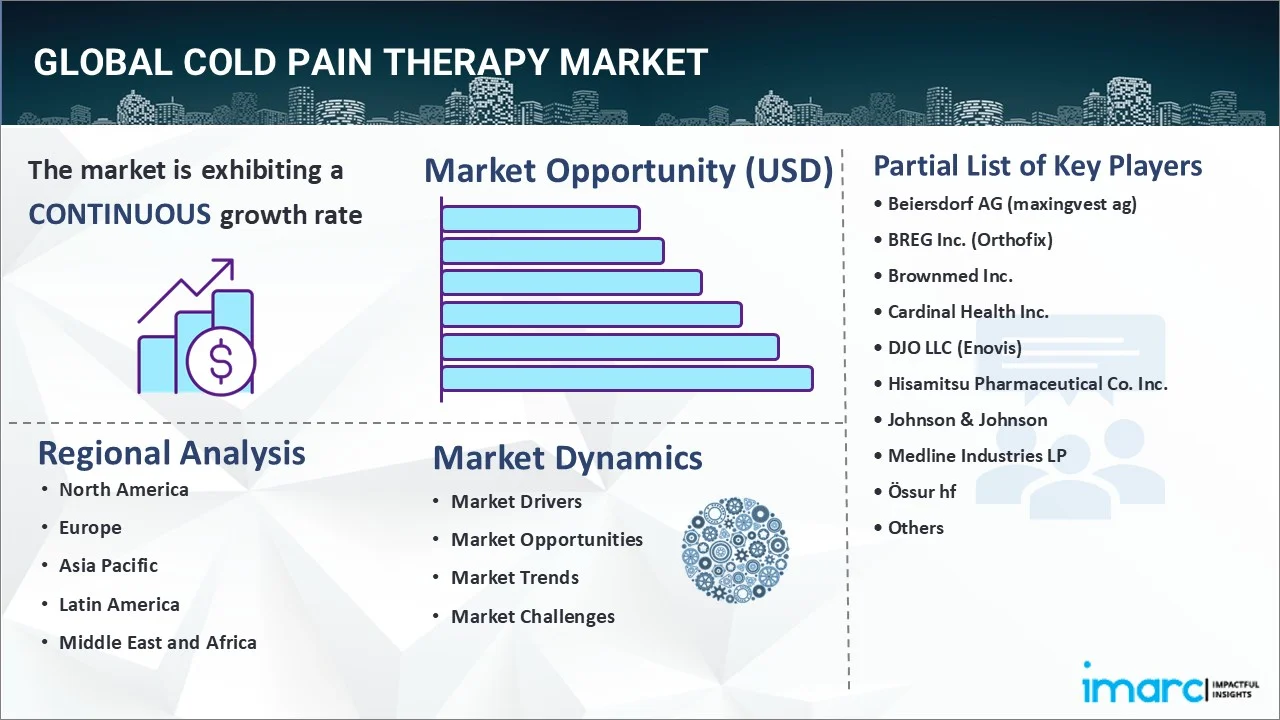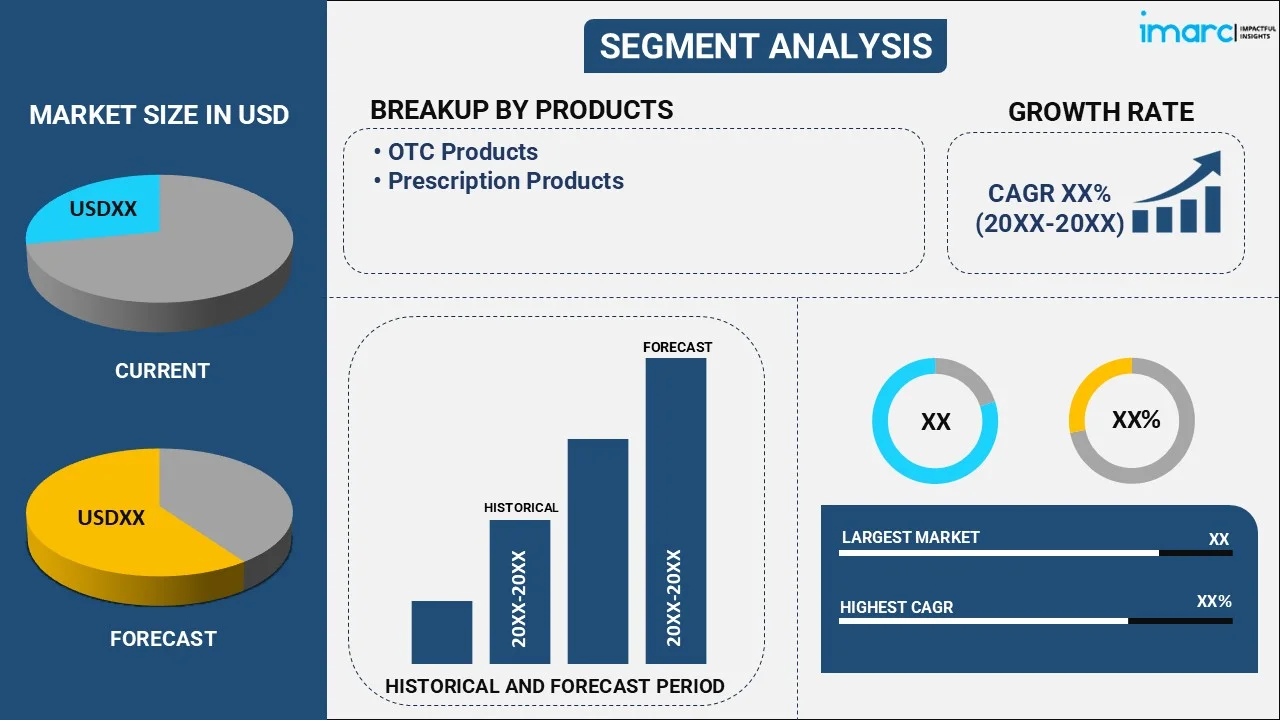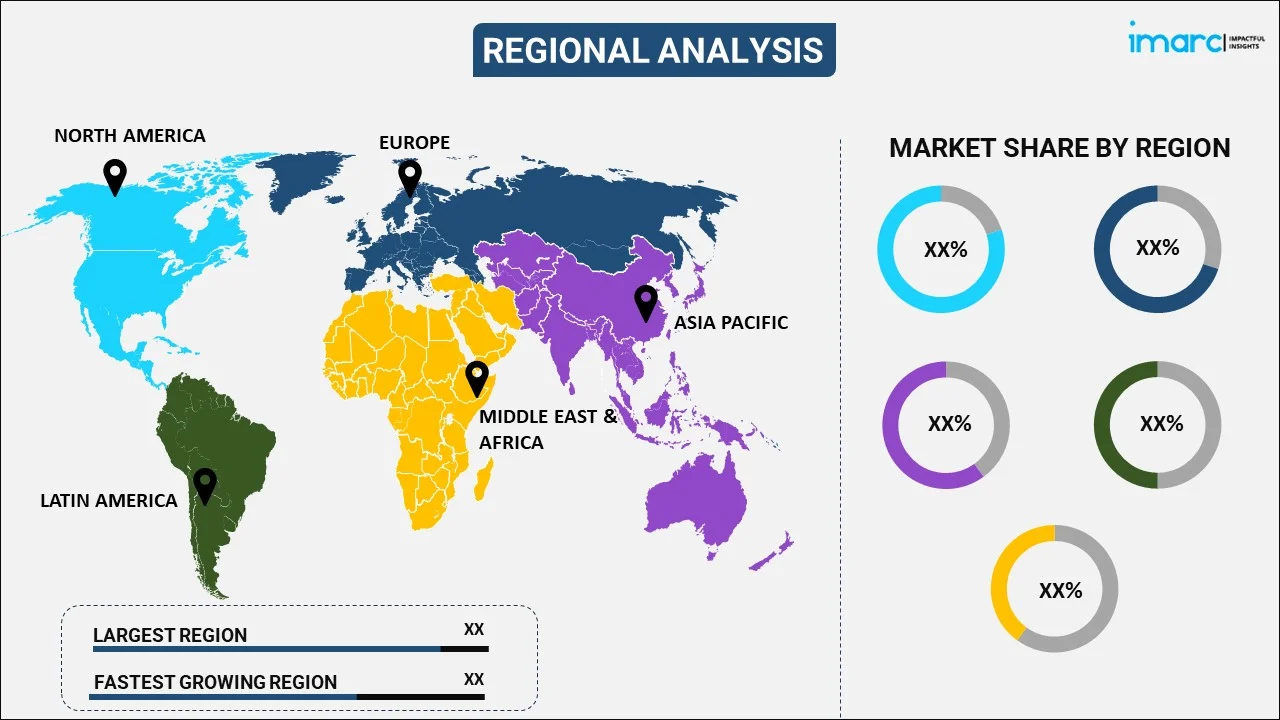
Cold Pain Therapy Market Report by Product (OTC Products, Prescription Products), Application (Musculoskeletal Disorders, Sports Medicine, Post-Operative Therapy, Post-Trauma Therapy), Distribution Channel (Hospitals Pharmacies, Retail Pharmacies, Online Pharmacies), and Region 2025-2033
Market Overview:
The global cold pain therapy market size reached USD 2.0 Billion in 2024. Looking forward, IMARC Group expects the market to reach USD 3.0 Billion by 2033, exhibiting a growth rate (CAGR) of 4.33% during 2025-2033. The rising prevalence of sports injuries, musculoskeletal disorders, and post-operative discomfort, shifting consumer preference towards non-invasive pain relief, and technological advancements in cold pain therapy devices are some of the major factors propelling the market.
|
Report Attribute
|
Key Statistics
|
|---|---|
|
Base Year
|
2024 |
|
Forecast Years
|
2025-2033
|
|
Historical Years
|
2019-2024
|
| Market Size in 2024 | USD 2.0 Billion |
| Market Forecast in 2033 | USD 3.0 Billion |
| Market Growth Rate (2025-2033) | 4.33% |
Cold pain therapy, also known as cryotherapy, is a non-invasive treatment that involves applying cold temperatures to reduce pain and inflammation in the body. This therapeutic method is typically used to alleviate acute injuries, such as strains, sprains, or post-surgical discomfort. The application of cold to the affected area constricts blood vessels, decreases tissue metabolism, and reduces nerve activity, thereby mitigating pain and swelling. Common cold pain therapies include ice packs, cold compresses, and specialized cooling devices. This approach is widely recognized for its analgesic properties and is often recommended in sports medicine, physiotherapy, and post-operative recovery protocols.

The global cold pain therapy market is primarily fueled by the rising prevalence of sports injuries, musculoskeletal disorders, and post-operative discomfort. Besides this, the increasing ageing population and a growing number of chronic diseases contribute to the expanding market as these conditions often result in persistent pain requiring therapeutic interventions. Furthermore, a shift in consumer preference towards non-invasive and drug-free pain relief methods has fostered the adoption of cold pain therapy. Concurrent with this, ongoing technological advancements, such as the development of portable and user-friendly cold therapy devices, are creating a favorable outlook for market expansion. Moreover, the escalating awareness among healthcare professionals and patients about the benefits of cold pain therapy in lowering inflammation and expediting the healing process is bolstering market expansion. In addition to this, the surging healthcare expenditures and continuous research and development (R&D) efforts by market players to introduce innovative products are strengthening the market growth.
Cold Pain Therapy Market Trends/Drivers:
Increasing prevalence of sports injuries, musculoskeletal disorders, and post-operative discomfort
The growing incidence of sports-related injuries, musculoskeletal disorders, and post-surgical pain is a major driver of the cold pain therapy market. These conditions often result in acute pain and inflammation, necessitating effective pain management solutions. Cold therapy, such as ice packs or cooling devices, is widely used to alleviate pain, reduce swelling, and accelerate the healing process in these cases. In line with this, the rising participation in sports and physical activities, along with an ageing population susceptible to age-related conditions, further contributes to the demand for cold pain therapy.
Shifting consumer preference towards non-invasive and drug-free pain relief
There is a noticeable trend among consumers and healthcare professionals towards non-invasive and drug-free pain relief methods. Cold pain therapy offers a safe and non-addictive alternative to pain medication, which is acting as a crucial growth-inducing factor. Apart from this, patients are increasingly seeking non-pharmacological approaches to manage pain, leading to a surge in the adoption of cold pain therapy methods. This shift in consumer preference is expected to drive the market as awareness about the benefits of cold therapy spreads.
Technological advancements in cold pain therapy devices
Advancements in technology have revolutionized the cold pain therapy market. Manufacturers have introduced portable and user-friendly cooling devices, making cold therapy more accessible and convenient for patients. These modern devices are designed to deliver controlled and targeted cooling, optimizing the therapeutic effects. Additionally, ongoing research and development (R&D) efforts have led to the innovation of novel products with improved features and functionality, creating a favorable outlook for market expansion. Besides this, the integration of smart technology and wearable cold therapy devices has further enhanced patient compliance and outcomes. As a result, healthcare professionals are increasingly recommending and utilizing these advanced cold pain therapy devices in various medical settings, boosting overall market growth.
Cold Pain Therapy Industry Segmentation:
IMARC Group provides an analysis of the key trends in each segment of the global cold pain therapy market report, along with forecasts at the global, regional, and country levels for 2025-2033. Our report has categorized the market based on product, application, and distribution channel.
Breakup by Product:

- OTC Products
- Gels, Ointments and Creams
- Sprays and Foams
- Patches
- Roll-Ons
- Cold Packs
- Others
- Prescription Products
- Motorized Devices
- Non-motorized Devices
OTC products dominate the market
The report has provided a detailed breakup and analysis of the market based on the product. This includes OTC (gels, ointments and creams, sprays and foams, patches, roll-ons, cold packs, and others) and prescription (motorized devices, non-motorized devices) products. According to the report, OTC products represented the largest segment.
The demand for both over the counter (OTC) and prescription cold pain therapy products is propelled by the rise in the prevalence of chronic conditions, such as arthritis and fibromyalgia, that require effective pain management solutions. Moreover, the rising health consciousness and awareness among consumers regarding self-care and non-invasive pain relief methods contribute to the popularity of OTC cold pain products. Besides this, the expanding geriatric population, which is more susceptible to age-related pain and discomfort, further boosts the demand for these products. Additionally, the expanding availability of a wide range of cold pain therapy products across various retail channels and the ease of accessibility encourage consumers to opt for OTC options, providing lucrative growth opportunities for the market.
Breakup by Application:
- Musculoskeletal Disorders
- Sports Medicine
- Post-Operative Therapy
- Post-Trauma Therapy
Musculoskeletal disorders hold the largest share in the market
A detailed breakup and analysis of the market based on the application has also been provided in the report. This includes musculoskeletal disorders, sports medicine, post-operative therapy, and post-trauma therapy. According to the report, musculoskeletal disorders accounted for the largest market share.
The rising incidence of musculoskeletal disorders and sports injuries necessitates effective pain management and accelerated healing, creating a demand for cold pain therapy methods. In addition to this, post-operative therapy often involves pain and inflammation management, where cold therapy proves beneficial in reducing discomfort and swelling, creating a positive outlook for market expansion. Additionally, the increasing use of cold pain therapies in post-trauma therapy for injuries or accidents due to their ability to alleviate pain and facilitate rehabilitation is contributing to the market's growth. Apart from this, the non-invasive nature of cold pain therapy makes it a preferred choice in these medical domains, leading to its increasing adoption among healthcare professionals and patients.
Breakup by Distribution Channel:
- Hospitals Pharmacies
- Retail Pharmacies
- Online Pharmacies
Retail pharmacies dominate the market
The report has provided a detailed breakup and analysis of the market based on the distribution channel. This includes hospitals pharmacies, retail pharmacies, and online pharmacies. According to the report, retail pharmacies represented the largest segment.
Hospital pharmacies play a vital role in driving sales as they cater to patients with acute injuries, post-operative care, and various medical conditions requiring immediate pain management. In addition to this, retail pharmacies act as accessible points of purchase for consumers seeking OTC cold pain therapy products, enhancing convenience and product visibility, which, in turn, is creating a favorable outlook for market expansion. Furthermore, the growing popularity of online pharmacies providing consumers with a convenient platform to purchase cold pain therapy products from the comfort of their homes, enabling a broader reach and offering a wide range of options, is acting as a significant growth-inducing factor. The combination of these distribution channels ensures the widespread availability and uptake of cold pain therapy products, contributing to overall market growth.
Breakup by Region:

- North America
- United States
- Canada
- Europe
- Germany
- France
- United Kingdom
- Italy
- Spain
- Others
- Asia Pacific
- China
- Japan
- India
- South Korea
- Australia
- Indonesia
- Others
- Latin America
- Brazil
- Mexico
- Others
- Middle East and Africa
North America exhibits a clear dominance, accounting for the largest cold pain therapy market share
The report has also provided a comprehensive analysis of all the major regional markets, which include North America (the United States and Canada); Europe (Germany, France, the United Kingdom, Italy, Spain, and others); Asia Pacific (China, Japan, India, South Korea, Australia, Indonesia, and others); Latin America (Brazil, Mexico, and others); and the Middle East and Africa. According to the report, North America accounted for the largest market share.
The demand for cold pain therapy in North America is primarily driven by the high prevalence of sports-related injuries and chronic musculoskeletal conditions, coupled with the increasing preference for non-invasive pain management methods. In addition to this, an ageing population and a rising incidence of age-related conditions such as arthritis in Europe contribute to the demand for cold pain therapy. Besides this, favorable reimbursement policies for cold therapy treatments in certain European countries further boost the market growth. Apart from this, the expanding healthcare infrastructure in the Asia Pacific region, combined with the increasing healthcare expenditure and escalating awareness about the benefits of cold pain therapy, is fueling the market growth. Moreover, the rise in the number of orthopedic surgeries and sports injuries in developing countries is aiding in market expansion.
Competitive Landscape:
The global cold pain therapy market exhibits a highly competitive landscape characterized by the presence of established players and new entrants seeking to gain a foothold in the industry. Key market participants include leading medical device manufacturers, pharmaceutical companies, and specialized cold therapy product suppliers. These companies engage in research and development (R&D) activities to introduce innovative and technologically advanced cold pain therapy products. Additionally, strategic collaborations, mergers, and acquisitions are prevalent strategies employed to expand their market share and geographic presence. Brand recognition, product quality, pricing, and distribution networks play crucial roles in shaping the competitive dynamics. Moreover, companies are investing in marketing and promotional activities to create awareness among healthcare professionals and consumers about the benefits of cold pain therapy.
The report has provided a comprehensive analysis of the competitive landscape in the market. Detailed profiles of all major companies have also been provided. Some of the key players in the market include:
- Beiersdorf AG (maxingvest ag)
- BREG Inc. (Orthofix)
- Brownmed Inc.
- Cardinal Health Inc.
- DJO LLC (Enovis)
- Hisamitsu Pharmaceutical Co. Inc.
- Johnson & Johnson
- Medline Industries LP
- Össur hf
- Performance Health Supply Inc. (Patterson Companies Inc.)
- Romsons Scientific & Surgical Pvt. Ltd.
- Unexo Life Sciences Pvt. Ltd.
Cold Pain Therapy Market Report Scope:
| Report Features | Details |
|---|---|
| Base Year of the Analysis | 2024 |
| Historical Period | 2019-2024 |
| Forecast Period | 2025-2033 |
| Units | Billion USD |
| Scope of the Report | Exploration of Historical and Forecast Trends, Industry Catalysts and Challenges, Segment-Wise Historical and Predictive Market Assessment:
|
| Products Covered |
|
| Applications Covered | Musculoskeletal Disorders, Sports Medicine, Post-Operative Therapy, Post-Trauma Therapy |
| Distribution Channels Covered | Hospitals Pharmacies, Retail Pharmacies, Online Pharmacies |
| Regions Covered | Asia Pacific, Europe, North America, Latin America, Middle East and Africa |
| Countries Covered | United States, Canada, Germany, France, United Kingdom, Italy, Spain, China, Japan, India, South Korea, Australia, Indonesia, Brazil, Mexico |
| Companies Covered | Beiersdorf AG (maxingvest ag), BREG Inc. (Orthofix), Brownmed Inc., Cardinal Health Inc., DJO LLC (Enovis), Hisamitsu Pharmaceutical Co. Inc., Johnson & Johnson, Medline Industries LP, Össur hf, Performance Health Supply Inc. (Patterson Companies Inc.), Romsons Scientific & Surgical Pvt. Ltd., Unexo Life Sciences Pvt. Ltd., etc. |
| Customization Scope | 10% Free Customization |
| Post-Sale Analyst Support | 10-12 Weeks |
| Delivery Format | PDF and Excel through Email (We can also provide the editable version of the report in PPT/Word format on special request) |
Key Questions Answered in This Report:
- How has the global cold pain therapy market performed so far, and how will it perform in the coming years?
- What are the drivers, restraints, and opportunities in the global cold pain therapy market?
- What is the impact of each driver, restraint, and opportunity on the global cold pain therapy market?
- What are the key regional markets?
- Which countries represent the most attractive cold pain therapy market?
- What is the breakup of the market based on the product?
- Which is the most attractive product in the cold pain therapy market?
- What is the breakup of the market based on the application?
- Which is the most attractive application in the cold pain therapy market?
- What is the breakup of the market based on the distribution channel?
- Which is the most attractive distribution channel in the cold pain therapy market?
- What is the competitive structure of the global cold pain therapy market?
- Who are the key players/companies in the global cold pain therapy market?
Key Benefits for Stakeholders:
- IMARC’s report offers a comprehensive quantitative analysis of various market segments, historical and current market trends, market forecasts, and dynamics of the cold pain therapy market from 2019-2033.
- The research study provides the latest information on the market drivers, challenges, and opportunities in the global cold pain therapy market.
- The study maps the leading, as well as the fastest-growing, regional markets. It further enables stakeholders to identify the key country-level markets within each region.
- Porter's five forces analysis assist stakeholders in assessing the impact of new entrants, competitive rivalry, supplier power, buyer power, and the threat of substitution. It helps stakeholders to analyze the level of competition within the cold pain therapy industry and its attractiveness.
- Competitive landscape allows stakeholders to understand their competitive environment and provides an insight into the current positions of key players in the market.
Need more help?
- Speak to our experienced analysts for insights on the current market scenarios.
- Include additional segments and countries to customize the report as per your requirement.
- Gain an unparalleled competitive advantage in your domain by understanding how to utilize the report and positively impacting your operations and revenue.
- For further assistance, please connect with our analysts.
 Inquire Before Buying
Inquire Before Buying
 Speak to an Analyst
Speak to an Analyst
 Request Brochure
Request Brochure
 Request Customization
Request Customization




.webp)




.webp)












